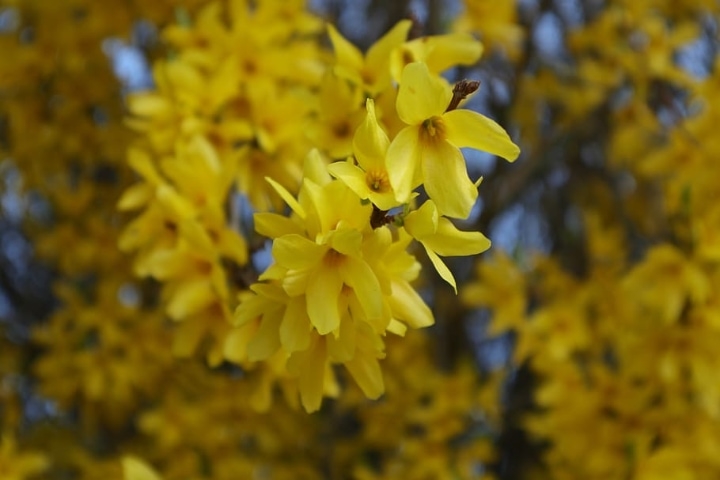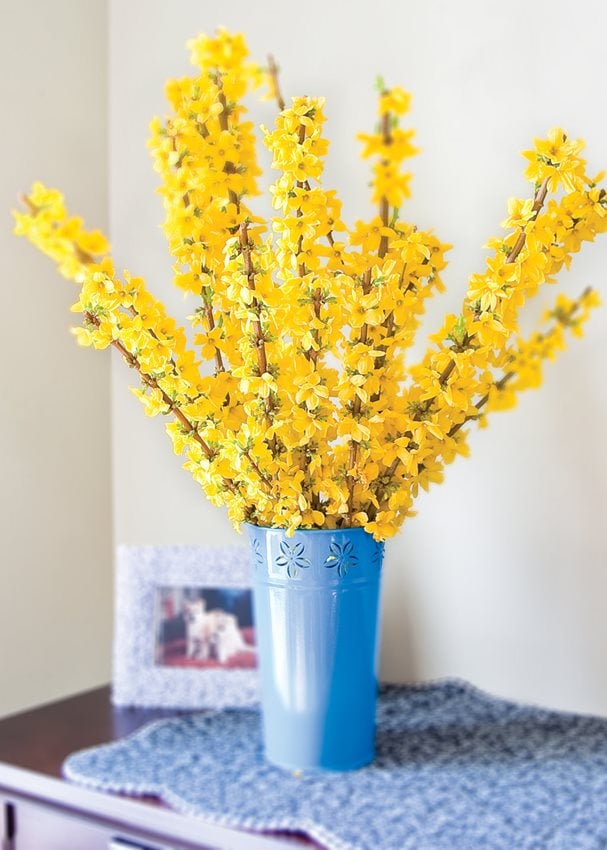The Golden Tide Of Forsythia Is Here
The Golden Tide of Forsythia is Here
The first signs of spring are finally here! Forsythia shrubs are in full bloom, their bright yellow flowers lighting up the landscape. If you're looking for a way to brighten up your yard or garden, forsythia is a great choice.
Forsythia is a deciduous shrub that is native to China and Korea. It is known for its early spring blooms, which can appear as early as March in some areas. The flowers are small and bell-shaped, and they are typically yellow, but can also be white or pink. Forsythia shrubs can grow to be 6-8 feet tall and wide, and they are relatively easy to care for.
If you're thinking about planting forsythia, there are a few things you should keep in mind. Forsythia shrubs need full sun to partial shade and well-drained soil. They are relatively drought tolerant once established, but they will benefit from regular watering during the first year after planting. Forsythia shrubs are also susceptible to pests and diseases, so it is important to inspect them regularly and treat any problems as soon as possible.
Once your forsythia shrubs are established, they will provide you with years of beautiful blooms. The Golden Tide of Forsythia is a truly stunning sight, and it is sure to brighten up your springtime landscape.
Main Content
Here are some additional facts about forsythia:
- The name "forsythia" comes from William Forsyth, a Scottish botanist who introduced the shrub to Europe in the early 1800s.
- There are over 50 different species of forsythia, but the most common type is Forsythia x intermedia.
- Forsythia shrubs are a good choice for pollinator gardens, as they attract bees, butterflies, and other insects.
- Forsythia shrubs can be pruned in the late winter or early spring to encourage new growth and flowering.
- Forsythia shrubs are relatively hardy and can tolerate a wide range of temperatures. However, they are not cold hardy in USDA zones 3 and below.
Conclusion
The Golden Tide of Forsythia is a beautiful sight that is sure to brighten up your springtime landscape. If you're looking for a way to add some color and cheer to your yard or garden, forsythia is a great choice. With its easy care requirements and beautiful blooms, forsythia is a shrub that will provide you with years of enjoyment.
Gold Tide Forsythia is a dwarf, deciduous shrub that is known for its bright yellow flowers that bloom in early spring. The flowers appear before the leaves, so your garden will be filled with a golden glow even before the rest of the plants have woken up from winter. Gold Tide Forsythia is also a very hardy plant, and it can tolerate a wide range of conditions, including full sun, part shade, and a variety of soil types.
If you're looking for a beautiful and easy-care shrub to add to your garden, Gold Tide Forsythia is a great choice. To learn more about this plant, visit Garden Wiki.
FAQ of gold tide forsythia
1. What is Gold Tide Forsythia?
Gold Tide Forsythia is a deciduous shrub that is known for its bright yellow flowers that bloom in early spring. It is a compact variety of forsythia, growing to only about 6 feet tall and 4 feet wide. Gold Tide Forsythia is relatively easy to care for and is tolerant of a variety of soil conditions. It is a good choice for planting in borders, hedges, or foundation plantings.
2. When does Gold Tide Forsythia bloom?
Gold Tide Forsythia typically blooms in early spring, from March to April. The flowers are bright yellow and appear before the leaves. The flowering period lasts for about two weeks.
3. How to care for Gold Tide Forsythia?
Gold Tide Forsythia is relatively easy to care for. It prefers full sun but can tolerate partial shade. It is drought tolerant once established, but it should be watered regularly during the first year after planting. Gold Tide Forsythia does not require a lot of fertilizer, but it can benefit from a light application of fertilizer in the spring. Pruning is not necessary, but it can be done to shape the shrub or remove dead or diseased branches.
4. What are some common problems with Gold Tide Forsythia?
The most common problem with Gold Tide Forsythia is leaf spot. Leaf spot is a fungal disease that can cause brown or black spots on the leaves. To prevent leaf spot, water the shrub at the base and avoid getting water on the leaves. If leaf spot does occur, you can treat it with a fungicide.
5. How to propagate Gold Tide Forsythia?
Gold Tide Forsythia can be propagated by cuttings or by division. To propagate by cuttings, take 4-6 inch cuttings from healthy stems in the spring or summer. Dip the cuttings in rooting hormone and plant them in a well-draining potting mix. Keep the cuttings moist and in a warm location. They should root in about 4-6 weeks. To propagate by division, dig up a mature shrub in the spring or fall and divide it into smaller sections. Each section should have at least 3-4 roots. Plant the divisions in well-draining soil and water them regularly. They should establish themselves in about 1-2 months.
Image of gold tide forsythia
5 different images of "gold tide forsythia" from pinterest.com:
- Image 1: A full grown gold tide forsythia bush in full bloom. The yellow flowers are clustered together in large bunches and cover the entire bush.

- Image 2: A close-up of the yellow flowers of a gold tide forsythia bush. The individual flowers are small and star-shaped, with a yellow center and yellow petals.

- Image 3: A gold tide forsythia bush in bloom against a blue sky. The yellow flowers stand out against the blue sky and make a beautiful sight.

- Image 4: A gold tide forsythia bush planted in a garden. The yellow flowers add a splash of color to the garden and make it look more vibrant.
- Image 5: A gold tide forsythia bush in a vase. The yellow flowers are arranged in a vase and make a beautiful centerpiece for a table.

Post a Comment for "The Golden Tide Of Forsythia Is Here"